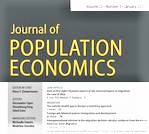A recent GLO Discussion Paper (also the GLO Discussion Paper of the Month March) had documented that the public health measures adopted in China have effectively contained the virus outbreak there already around February 15. Now a substantially revised version of the paper based on rigorous peer review has been accepted for publication in the Journal of Population Economics.
“Impacts of Social and Economic Factors on the Transmission of Coronavirus Disease 2019 (COVID-19) in China” by Qiu, Yun & Chen, Xi & Shi, Wei
Forthcoming: Journal of Population Economics, Issue 4, 2020.
PDF of the prepublication revised draft.
OPEN ACCESS OF ONLINE PUBLISHED VERSION.
Major Findings
- Stringent quarantine, city lockdown, and local public health measures imposed since late January significantly decreased the virus transmission rate.
- Population outflow from the outbreak source region posed a higher risk to the destination regions than other factors including geographic proximity and similarity in economic conditions.
- Over 1.4 million infections and 56,000 deaths could have been avoided according to the estimates based on the analysis.
- Most effective was found to be “city lockdown” first followed by “closed management of communities” and “family outdoor restrictions”.
GLO Discussion Paper of the Month: March
GLO Discussion Paper No. 494, 2020: GLO Discussion Paper of the Month: March
Impacts of Social and Economic Factors on the Transmission of Coronavirus Disease 2019 (COVID-19) in China
by Qiu, Yun & Chen, Xi & Shi, Wei
PDF of the GLO Discussion Paper
Related interview: #Coronavirus and now? GLO – Interview with Top #Health Economist Xi Chen of Yale University
Other related GLO activities.
GLO Fellows Yun Qiu & Xi Chen & Wei Shi
- Yun Qiu & Wei Shi are Professors at the Institute for Economic and Social Research (IESR), Jinan University, China
- Xi Chen is a Professor at Yale University & President of the China Health Policy and Management Society

Yun Qiu 
Xi Chen 
Wei Shi
Revised Abstract: This paper models the local and cross-city transmissions of the novel coronavirus in China between January 19 and February 29 in 2020. We examine the role of various socioeconomic mediating factors, including public health measures that encourage social distancing in local communities. Weather characteristics two weeks ago are used as instrumental variables for causal inference. Stringent quarantine, city lockdown, and local public health measures imposed since late January significantly decreased the virus transmission rate. The virus spread was contained by the middle of February. Population outflow from the outbreak source region posed a higher risk to the destination regions than other factors including geographic proximity and similarity in economic conditions. We quantify the effects of different public health measures in reducing the number of infections through counterfactual analyses. Over 1.4 million infections and 56,000 deaths could have been avoided as a result of the national and provincial public health measures imposed in late January in China.

Ends;

